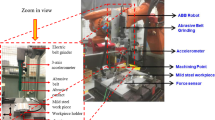Abstract
One of the main sources of inaccuracy in production is machine tool errors. In this study, a method is introduced to model and compensate positional, geometrical, and thermally induced errors of machine tools by an offline technique. Thermal errors are modeled by three ways of multiple linear regression, artificial neural networks, and neuro-fuzzy modeling. The required database is provided by measuring errors using a laser interferometer. Subsequently, the models are evaluated and the best one which is neuro-fuzzy with a mean square error of 0.375 μm is chosen to predict the errors using developed software. The experimental procedure is optimized by a preliminary broad assessment. Volumetric errors are calculated using rigid body kinematic and applied to modify the initial G-codes. The introduced method is validated by compensating errors on a free-form which shows significant average improvement of errors.
Similar content being viewed by others
References
Ocafor AC, Ertekin YM (2000) Derivation of machine tool error models and error compensation procedure for three axes vertical machining center using rigid body kinematics. Int J Mach Tool Manuf 40:1199–1213
Chen L, Tsutsumi M (1996) Measurement and compensation of corner tracking errors of CNC machine tools. Int J Jpn Soc Precis Eng 30(4):331–336
Bryan JB (1968) International status of thermal error research. Ann CIRP 16:203–215
Hao Wu, Hongtao Z, Qianjian G, Xiushan W, Jianguo Y (2008) Thermal error optimization modeling and real-time compensation on a CNC turning center. J Mater Process Tech 207(1–3):172–179
Kim JD, Kim DS (1997) Development and application of an ultra-precision lathe. Int J Adv Manuf Tech 13:164–171
Kim HS, Jeong KS, Lee DG (1997) Design and manufacture of a three-axis ultra-precision CNC grinding machine. ASME Trans J Mater Process Tech 71:258–266
Vahebi Nojedeh M, Habibi M, Arezoo B (2011) Tool path accuracy enhancement through geometrical error compensation. Int J Mach Tool Manuf 51(6):471–482
Habibi M, Arezoo B, Vahebi Nojedeh M (2011) Tool deflection and geometrical error compensation by tool path modification. Int J Mach Tool Manuf 51(6):439–449
Li S, Zhang Y, Zhang G (1997) A study of pre-compensation for thermal errors of NC machine tools. Int J Mach Tool Manuf 37(12):1715–1719
Jedrzejewski J, Kaczmarek J, Kowal Z, Winiarski Z (1990) Numerical optimization of thermal behavior of machine tools. Ann CIRP 39(1):379–382
Kim SK, Cho DW (1997) Real-time estimation of temperature distribution in a ball-screw system. Int J Mach Tool Manuf 37(4):451–464
Haitao Z, Jianguo Y, Jinhua S (2007) Simulation of thermal behavior of a CNC machine tool spindle. Int J Mach Tool Manuf 47:1003–1010
Huang SC (1995) Analysis of a model to forecast thermal deformation of ball screw feed drive systems. Int J Mach Tool Manuf 35(8):1099–1104
Veldhuis SC, Elbestawi MA (1995) A strategy for the compensation of errors in five-axis machining. Ann CIRP 44(1):373–378
Yang M, Lee J (1998) Measurement and prediction of thermal errors of a CNC machining center using two spherical balls. Int J Mater Process Tech 75:180–189
Pai-Chung Tseng (1997) Real-time thermal inaccuracy compensation method on a machining center. Int J Adv Manuf Tech 13(3):182–190
Chen JS, Yuan J, Ni J (1996) Thermal error modeling for real-time error compensation. Int J Adv Manuf Tech 12(4):266–275
Pahk HJ, Lee SW (2002) Thermal error measurement and real time compensation system for the CNC machine tools incorporating the spindle thermal error and the feed axis thermal error. Int J Adv Manuf Tech 20:487–494
Wang KC, Tseng PC, Lin KM (2006) Thermal error modeling of a machining center using grey system theory and adaptive network-based fuzzy inference system. JSME Int J 49(4):1179–1187
Eskandari S, Arezoo B, Abdullah A (2012) Thermal errors modeling of a CNC machine’s axis using neural network and fuzzy logic. Appl Mech Mater 110–116:2976–2982
Okafor AC, Ertekin YM (2000) Derivation of machine tool error models and error compensation procedure for three axes vertical machining center using rigid body kinematics. Int J Mach Tool Manuf 40:1199–1213
Ross TJ (2004) Fuzzy logic with engineering applications, 2nd edn. Wiley, Chichester
Jue LS, Sen OC (2003) A neuro-fuzzy system modeling with self-constructing rule generation and hybrid SVD-based learning. IEEE Trans Fuzzy Syst 11(3):341–353
Castellano G, Faneli AM (2001) A self-organizing neural network inference network. Dissertation, University Degli Studi Di Bari
Feng JC, Teng LC (1998) An on-line self-constructing neural fuzzy inference network and its application”. IEEE Trans Fuzzy Syst 6(1):12–32
Dragan K, Emil L (2004) Identification complex system based on neural and Takagi-Sugeno fuzzy model. IEEE Trans Syst Man Cybern B 34(1):272–282
Author information
Authors and Affiliations
Corresponding author
Rights and permissions
About this article
Cite this article
Eskandari, S., Arezoo, B. & Abdullah, A. Positional, geometrical, and thermal errors compensation by tool path modification using three methods of regression, neural networks, and fuzzy logic. Int J Adv Manuf Technol 65, 1635–1649 (2013). https://doi.org/10.1007/s00170-012-4285-y
Received:
Accepted:
Published:
Issue Date:
DOI: https://doi.org/10.1007/s00170-012-4285-y




